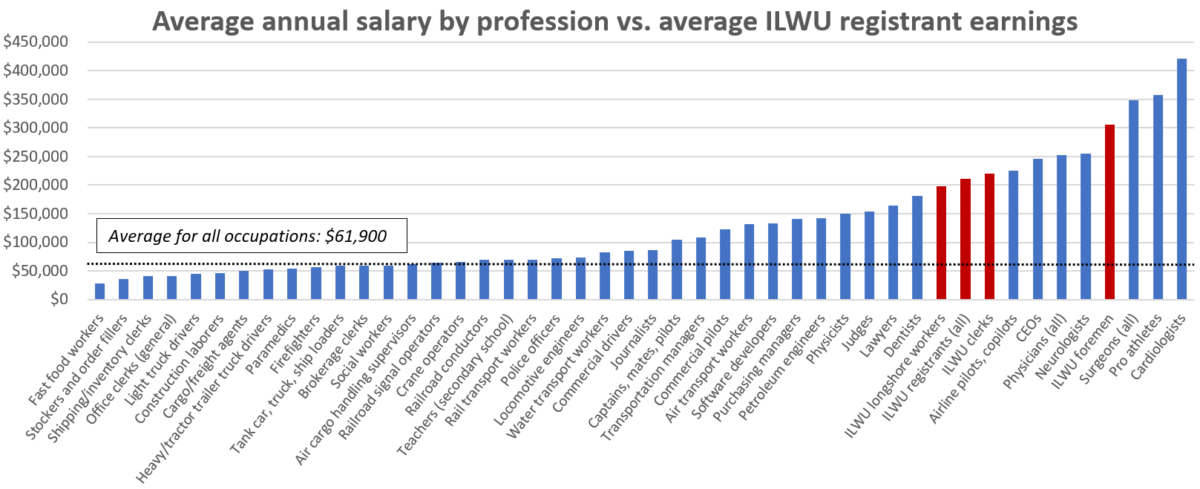Highly Paid ILWU Workers Want More, So Shippers Pay the Price
The latest International Longshore & Warehouse Union (ILWU) labor action that shut down terminals and slowed down port operations up and down the West Coast is all about money. The ILWU is demanding big pay raises for its workers, who are already among the top paid people in the country. By all reports, the demand for more money is what was behind all the port disruption this week and last.
The Disruption for Higher Pay
In a news flash email today, All-Ways summed up the situation pretty well:

The ILWU wants to raise their wages to increase more than 100% over the 6-year contract, so they’re holding up cargo across the West Coast?
Yes, you heard that right!
Wage disparity is the root of this past week’s job actions.
The ILWU wants a $7.50/hour increase for each year of the new contract but the PMA [Pacific Maritime Association] generally has only increased hourly rates by 50 cents to $1.50! Plus, the ILWU wants all longshore workers to be paid 2 hours overtime for any 8-hour shift worked.
1️⃣ After negotiations were suspended on Tuesday following the death of an ILWU worker caused by a stroke, the Port of Oakland was shut for Wednesday’s morning shift.
2️⃣ Crane productivity at the Port of Seattle was at 30% of usual – so low that dockworkers were sent home.
3️⃣ Tacoma, on the other hand, remained in operation even with their crane productivity of 50%.
4️⃣ The ILWU’s refusal to send lashers, workers who secure the top row of containers to the vessel, caused the ports of Los Angeles and Long Beach to experience delays in vessel departures. At least 6 vessels that were worked on and scheduled for departure were anchored because the final step could not be completed.
5️⃣ This is causing disruptions to other parts of the supply chain. Union Pacific Railroad reported that service at 3 marine terminals in Los Angeles-Long Beach was temporarily suspended because of freight backups at their inland terminals.
In a FreightWaves article, Greg Miller reported how the labor action “over the size of dockworkers’ next pay raise” is affecting ship operations:
“We got a rash of vessel movements canceled overnight,” said Kip Louttit, executive director of the Marine Exchange of Southern California, on Wednesday.
Departures of six ships berthed in Los Angeles or Long Beach have been delayed: the Cosco Portugal, Cosco Oceania, Cosco Shipping Rose, CMA CGM Amerigo Vespucci, CSCL Yellow Sea and YM Unicorn. Arrivals of four ships to the ports are delayed: the Aitolikos, Cosco Denmark, Cosco Netherlands and Cosco Taicang. Yet another ship, the MSC Jeongmin, had its arrival in Los Angeles delayed Tuesday.

Shippers Exasperated
Of course, it all ultimately means costly delays for shippers importing and exporting cargo. That’s become the expectation whenever it’s time for the ILWU to negotiate a new contract. To describe this as frustrating for shippers would be a massive understatement.
Maybe it would be understandable if ILWU workers were poorly paid. But they’re not. In fact, they’re among the best paid workers in the country.
For shippers watching, the slowdowns and shutdowns ILWU workers cause as they demand more money feels like watching Dudley Dursley throw a tantrum because he only got 36 presents for his birthday this year, which is two less than last year. Nevermind that this year’s lot – including a computer, a gold wristwatch, and a cinema-level camera – is more expensive. It’s not enough, so everyone has to pay.
Wait, How Much Do ILWU Members Make?!
Miller’s FreightWaves article, without comparing the ILWU to Harry Potter’s fat cousin, is quite scathing by simply sharing detailed ILWU compensation data that the PMA publishes annually. Here are some highlights:
Full-time registered longshore workers earned an average of $197,514 in 2022, not including benefits, according to the PMA. Clerks earned an average of $220,042 and foremen and walking bosses averaged $306,291. (Full time is defined as working 2,000 hours or more per year, or 38.4 hours per week.)
The PMA also paid $100,534 per ILWU registrant in benefits costs. Benefits include full insurance coverage, a 401(k) and a pension with a maximum yearly retirement benefit of $95,460.
…
The average 2022 ILWU registrant base rate — $46.23 per hour — doesn’t sound that steep for skilled labor. But as the PMA explained in its annual report, worker earnings also include an additional component based on skill level. Skill bonuses range from $2.40 to $5.80 per hour and were added in 80.7% of hours paid last year.
Pay also increases for the second shift (eight hours starting at 6 p.m.) and third shift (five hours starting at 2:30 a.m.) to $61 to $83 per hour. Work on these shifts accounted for 38.5% of total hours paid last year.
Then there is overtime, which accounted for 36.4% of hours paid in 2022. Overtime pay rates range from $69 to $93 per hour. Altogether, the PMA said the effects of skills bonuses, work shifts and overtime brought the effective average rate for all hours paid to $64.10.
Perspective by Comparison
Most Americans would be thrilled by getting ILWU pay. But Miller really puts it in perspective when he compares those numbers to what people in other professions in the U.S. make:
The U.S. Bureau of Labor Statistics compiles data on average annual wages by profession. West Coast dockworkers rank toward the top when compared to the government stats.
Full-time dock foremen earned 24% more than the average CEO’s base salary in 2022 and 20% more than neurologists. ILWU clerks earned just $5,600 per year less than airline pilots. Full-time dockworkers came in 21% higher than lawyers and 9% above dentists.
Average earnings in 2022 for all full-time ILWU registrants — $211,000 — were 3.4 times higher than the average wage for all professions calculated by the Bureau of Labor Statistics.
When Miller showed the data in a graph, how much ILWU workers make really jumps out at you:

Incredibly, only surgeons, pro athletes, and cardiologists rank ahead of ILWU foremen on how much they make.
Conclusion
I have no problem with people making money, dockworkers in particular. Working on the docks is important and even relatively dangerous work. They deserve to be well-paid. However, when you’re highly paid, as ILWU members are, I do have a problem with you damaging other people’s livelihood in demands to make more.
Additionally, the ILWU damages the future security of its own jobs with the disruption it creates every time a contract expires or when the union tries to take jobs away from other unions. Cargo gets diverted from West Coast ports, some of it never to return. That can mean fewer hours, fewer jobs for ILWU members. Importers and exporters who shipped through the Port of Portland won’t likely forget cargo ships ceasing to call on the port altogether because ILWU members slow-timed it so much over not getting two jobs that had always belonged to another union. How many dockworker jobs did that cost?
The union seems to want to create a narrative that its workers are somehow mistreated. Their greedy employers made billions during the pandemic, taking advantage of the poor workers. Well, those workers are far from poor. The ILWU wants the next contract to be much bigger because of how much was made during the shipping boom of the pandemic. Well frankly, ILWU members were, of course, paid well during that boom:
The PMA paid ILWU registrants at all U.S. West Coast ports total wages of $2.31 billion in 2022, up $371 million or 19% versus 2019, pre-pandemic. The effective hourly rate rose 7% over the three-year period. Straight time was 22,895,230 hours in 2022, up 8% from 2019. Overtime came in at 13,084,540 hours, up 16%.
–Miller’s FreightWaves article
But surprise, surprise, Dudley didn’t get enough. So let’s just shut down the ports until Uncle Vernon runs out and buys twice as many gifts. Shippers should be fed up.
Since this has been a harsh post on the ILWU, I’ll include one more bit from Miller’s article because it includes a caveat on the ILWU compensation data:
The caveat on the PMA data is that a portion of union registrants are under the full-time threshold. Of longshore workers, 42% worked less than 2,000 hours in 2022. The bulk of longshore workers (including non-full-time workers) earned in the $100,000-$200,000 range.
Among clerks, 19% worked less than 2,000 hours, with overall earnings bunched in the $150,000-$225,000 range. Of walking bosses and foremen, only 10% did not meet the full-time definition. Salaries were grouped in the $250,000-$325,000 range. Some foremen earned over $400,000 and a few topped a half-million.
Even the caveat isn’t that strong in the union’s favor, unfortunately. Even more unfortunate is that the ILWU and PMA seem far apart on this pay issue, and that likely will continue to be costly for shippers.





